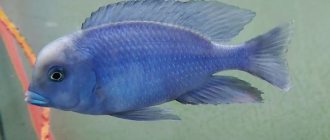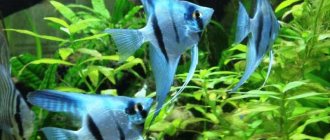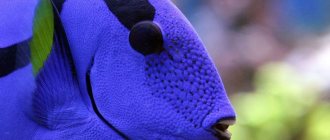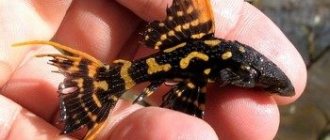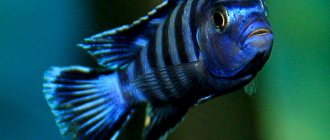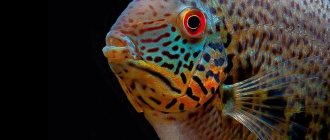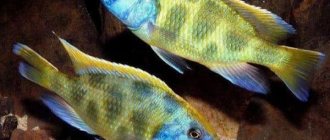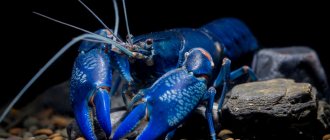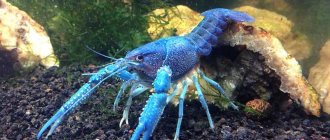10/04/2019Pisces0
Blue Dolphin - Cyrtocara moorii or as previously known as Haplochromis moorii belongs to the cichlid family (Cichlidae). It gained fame due to its beautiful coloring and unique body shape - it resembles a dolphin with a large bump on its forehead.
- 1 Description and natural habitat
- 2 Mr. Tail Recommends: Basics of Aquarium Keeping
- 3 Compatibility
- 4 Feeding
- 5 Breeding
- 6 Diseases and prevention
Motherland
The blue dolphin, or Cyrtocara, is prized for its unusual shape and coloring.
The natural habitat of the endemic species is in the shallow sandy areas of Lake Malawi, which is located in Africa. Representatives of this species can also be found in lakes Edward and Victoria.
There are several varieties of blue dolphins. First of all, fish with a bright blue or velvety blue color are valued. The presence of a large bump on the forehead is also important. If it was possible to breed individuals without a pronounced growth, then they will not be in demand.
Blue dolphins can have different color intensities depending on gender, species, and conditions of detention.
This fish was discovered and described by George Albert Boulanger in 1902. The species first appeared in Europe in 1968.
The fish quickly gained popularity due to its bright coloring and the absence of problems in breeding. In artificial reservoirs, the blue dolphin lives up to 10 years. The maximum size is 25 cm, but in an aquarium dolphins usually reach 15 cm.
The difference between a male and a female
You need to know that in the blue dolphin cichlid, the differences between the female and the male are insignificant, so you need to make an effort to find them.
They have the same coloring and both have a hump on their forehead. However, males can be larger in size and also have a more prominent hump on the head, but this takes several years. Males can also be brighter in color. The male can be distinguished from the female by indicative vertical stripes, the number of which varies from 4 to 7.
Care and maintenance
Water parameters:
| Volume per 1 individual | Temperature | Alkalinity | Rigidity |
| 100 l | 24 - 28 Co | 10-18 dKH | Ph 7.2-8.5 |
Cichlids prefer clean and clear water. For this reason, the aquarium requires good aeration, as well as powerful filters. Water changes occur once a week. It is enough to replace a third of the volume. It is also important to provide good lighting.
If the water is too soft, add coral chips to the sand at the bottom of the aquarium.
Nutrition
The blue dolphin is a predator in natural conditions. If you keep such an individual in an aquarium and feed it with small fish, you should first make sure that they are completely healthy. The dolphin can catch an infection and get sick.
Sometimes aquarium fish are offered meat or minced meat. It is worth considering that the fish’s body cannot fully assimilate such food. When blue dolphins are fed such foods for a long time, obesity and degeneration of some internal organs occur.
When it comes to dry food, preference should be given to ready-made mixtures prepared specifically for cichlids.
It is worth feeding the fish with special food for cichlids. Most often, the composition includes special additives and vitamins that make the color of the fish brighter. But the most important rule of nutrition is variety. The diet should include both dry and live food.
Arrangement of the aquarium
This aquarium fish prefers space. A thick layer of clean sand is laid out at the bottom because blue dolphins love to burrow in it. It is very important to arrange places for shelter, for example artificial grottoes made of stones or driftwood. But don't forget about the space for free swimming.
There is no need to arrange intricate decor in an aquarium for blue dolphins - the fish are already very attractive and interesting!
Among algae, preference should be given to hard-leaved plants with strong roots. The most commonly planted species are:
- Vallisneria;
- Anubias;
- cryptocoryne;
- limnophila;
- fern.
Since the fish is very strong, it can pull out algae with its roots. Therefore, you should give preference to plants in pots. You can also place floating or artificial algae for the fish to enjoy.
Who linked the Blue Whale game to mass teenage suicides?
The news of the revival of “death groups” was predictably perceived as a threat on a global scale. Even Instagram, which has been ignoring the law on personal data for several years now, discussed the situation with Roskomnadzor and removed more than 300 links with suicidal content.
True, this did not help much in the fight against the spread of the new sinister game, which this time was nicknamed “Blue Whale”. And for this we should say special thanks to the media. Having disguised the increase in traffic as coverage of a socially important topic, journalists from hundreds of publications immediately delved into the investigation and, together with experts, began to build theories about who was behind the bloody flash mob.
For example, the vice-president of the Russian Criminological Association, Doctor of Philosophy Igor Sundiev blamed everything on the hybrid war, designed to “reverse the trend towards demographic growth.” Journalist Alexander Milkus talks about “echoes of the special operation against Russian teenagers.”
The popularization of the game “Blue Whale” caused hysteria in the media.. Photo: Alexey Filippov / TASS
The author of the original text about “death groups,” Novaya Gazeta columnist Galina Mursalieva, stopped complaining about the “online peacocks” trolling her for her book “Child Safety Helmet on the Internet,” and took up her pen again, not being afraid to talk to one of the anonymous “ curators."
He threatened a certain volunteer with “criminal language and knowledge of his exact address,” and Galina herself admitted that he does not work in Russia and receives a reward for every child death.
“The virtual maniac says that 60 children will commit suicide in the near future. Then he gets better - 70. To be more convincing, a day later he reports that things have gone well, and sends photographs of children’s hands, quite badly cut. Perhaps it's photoshopped. And if not?" — the author gets angry and complains about the reluctance of investigators to “check the IP addresses of the instigators and immediately come to them with a search warrant.”
Compatibility
Blue dolphin is compatible with the following fish:
- catfish;
- barb;
- cichlids (regardless of size);
- frontosis.
The compatibility table applies to all cichlids, including dolphins.
Most often, cichlid severum, a false discus fish, is kept in the same aquarium with dolphins. Representatives of this species are also distinguished by their peaceful nature.
Very poor compatibility with mbuns. In such cases, conflicts cannot be avoided.
Interesting Facts
- It was once believed that one of the main products in the diet of cyclids in an aquarium was meat, such as poultry or pork. Researchers have proven that it is the components of these types of meat that lead to organic disorders in organisms with cichlase.
- Synonymous names for the species: blue dolphin, haplochromis muri, cirtocara muri.
- Cichlids have one nostril on each side, while other fish have 2 pairs. To sense the “smells” in the water, they suck in the water and then push it back out.
Diseases
Inflammation of the gastrointestinal tract
The reason is low quality feed. Signs: distended abdomen, redness in the anal area, difficulty breathing, undigested food in excrement, constipation, passive behavior, lack of appetite. Can lead to death, especially at a young age.
For treatment, it is necessary to replace the water, fulfill all sanitary requirements for temperature conditions and aeration. Fast the fish for 2-3 days. After this, feed fresh coretra, daphnia or cyclops in small portions.
Peptic ulcer
It may appear along with soil, contaminated food, or the introduction of sick fish into the aquarium without prior quarantine. Ulcers appear on the body. If left untreated, the ulcers will penetrate inside. To get rid of the problem, use a solution of trypaflavin or potassium permanganate.
Peptic ulcer disease - hexamitosis, leaves marks on the body of those cured for life!
Cold
This disease can develop after transportation at low air temperatures. The surface of the body becomes covered with unpleasant mucus, the gills become inflamed, and the color fades. A cold weakens the immune system and can lead to complications. In order to speed up the healing process, the most favorable conditions are provided for the dolphins - optimal temperature, good air exchange and light food.
Diseases that can affect dolphins can be caused by stagnant water, poor-quality or expired food, or stress.
Description
The fish was so nicknamed because of its external resemblance to the mammal dolphin. Blue or blue cichlid is decorated with:
- black spots;
- the convex shape of the forehead has a layer of fat;
- large mouth protrudes forward;
- eyes are enlarged and constantly moving;
- large head;
- the fin on the back is quite long. It starts from the head and ends at the base of the ridge. The caudal fin is two-lobed. The fins on the chest and abdomen are small and undersized;
- height can reach 25 cm;
- life expectancy is up to 15 years.
The body of the cichlid is compressed and elongated. Large dark spots are located on the tail and in the central part of the body. The sides are decorated with transverse stripes. In conflict situations, the color takes on a bright blue hue, and the fins and throat become black.
Reproduction
For breeding at home, 15 fry are bought and raised in one flock. After individuals reach a size of 12 cm, they develop gender characteristics. Boys are usually larger than girls. The frontal part of the male is larger and more saturated in color. Females retain stripes on their sides.
The main difference between a male and a female is his fatty bump on the forehead, in addition, the male blue dolphin is brighter and larger than the female.
Sexual maturity occurs at 1 year. At the same time, the lifespan of dolphin fish is 10 years, there is information that some individuals live up to 15.
Blue dolphins are polygamous. For a full-fledged flock, it is enough to have two or three males and five to six females. The strongest will fertilize the eggs, but over time it will give way to another.
06:05
Blue dolphin. Keeping peaceful cichlids from the lake. Malawi.
During the mating season, the male determines the place where the female should lay eggs. Most often this is a small hole on the surface of the soil or a flat stone. The male becomes much brighter, the frontal fatty growth becomes yellow, and stripes of a dark blue hue form on the sides. All these changes attract the female. She lays eggs (about 90 eggs).
The next stage is fertilization of the eggs by the male.
The female picks up the fertilized eggs with her mouth and carries them there during the entire incubation period, which lasts from two to three weeks.
A female blue dolphin loses a lot of weight during the period of bearing her calves.
The fry, later, also hide in the mother's mouth, especially at night.
In order for the breeding process to occur successfully, it is worth removing all other inhabitants of the aquarium. Otherwise, the alpha male may destroy other fish. There is also a high probability that the female will simply eat the eggs out of stress.
The incubation period depends on the temperature of the water in the aquarium. At this time, the male jealously guards the female or fry that have hatched. The female, on the contrary, becomes impressionable and fearful.
During the first spawning, fry are produced very rarely. The female is inexperienced and can swallow the eggs by accident or out of fright.
Breeding
The first reproduction in an artificial environment was recorded in 1978. To be successful in this process, it is necessary to properly care and prepare the breeders. It is important to ensure proper feeding. A week before spawning, it is advisable to introduce worms into the diet. A stable result in reproduction can be obtained at the age of individuals 14-18 months and up to 8 years; an earlier period is undesirable.
The male's readiness is determined by changes in his color and behavior (chasing females and aggressiveness towards males). Before the spawning process begins, future parents prepare a special platform on the ground. Females that have collected eggs sink to the bottom to a prepared place and begin spawning games. They carry out circular movements and lay eggs. At the next turn, they suck it into the mouth and swim up to the male, forcing him to spray the water with milk. Having received them, they draw them into themselves for fertilization. The whole process lasts about 1 hour, as a result, about a hundred eggs (large, oval 2.5 mm) are laid. The pillow over the forehead increases before reproduction and becomes larger each time.
The female holds the eggs in her mouth throughout the incubation period (3 weeks). After hatching, the fry stay with her for some time, going out to play at night while the other inhabitants are sleeping. Their mother releases them only when they reach a size of 1 cm. During this period, the color of the juveniles is steel, after some time the color of the fins becomes red and dark spots appear. The number of offspring obtained is 40-60%.
With any irritating factor, the female can throw off the eggs or swallow them, so it is better to place them separately.
You can raise fry in a special incubator without a female. To preserve them, it is necessary to maintain a temperature of +27...+28 °C, maintain good water filtration and organize proper nutrition: regular and nutritious. At the first stage, the nauplii are fed with artemia and crustaceans, later vitamin supplements, tubifex and chironomids are added. The growth of the fry per month is 1-1.5 cm. After 4 cm, their outfit turns blue.
Reviews
During the period of gestation, the female does not have the opportunity to eat fully. Sometimes aquarists remove the eggs from the fish’s mouth and hatch it in a separate spawning tank. But this does not always work out, since the female can swallow all the eggs out of fright. Alexandra, 62, Perm
If the female is inexperienced, she may not be able to withstand hunger and swallow future babies. Also often other females begin to tease her. As a result, the first brood dies. Leonid
You should not buy dry food by weight. In this case, it is almost impossible to control the quality and expiration dates of food. The food must be stored in a closed package, otherwise pathogenic organisms will begin to develop in it. I add food of plant origin. But most of the blue dolphin's daily diet consists of protein foods. Lyudmila Igorevna, Voronezh
Feeding
Cichlid blue dolphins are predators that feed on live food. They require a varied diet, protein and plant foods. Many aquarists feed them with ready-made food from the pet store. This is not enough for proper nutrition, so experts advise giving live food from time to time. The basis of the diet is brine shrimp and tubifex. Live food must be pre-treated to avoid infecting the dolphin with bacteria or harmful microorganisms.
The fish should be fed in moderation and in doses. Excess feed will lead to obesity.
